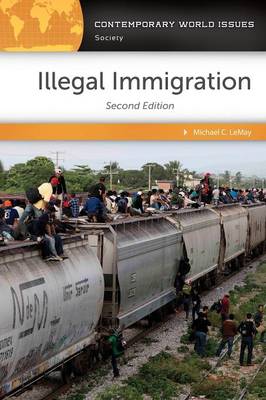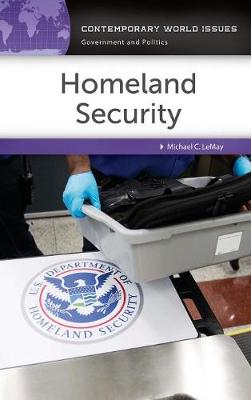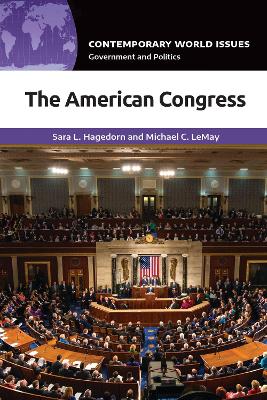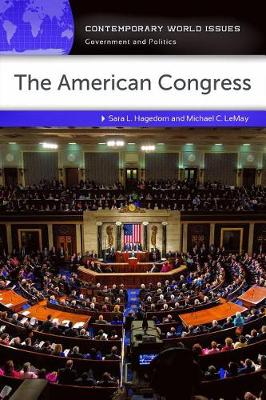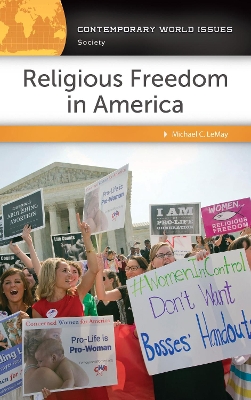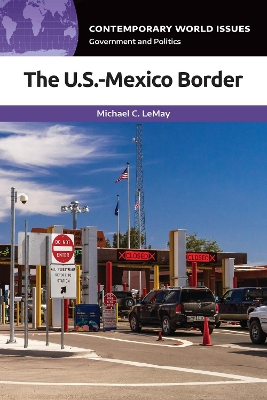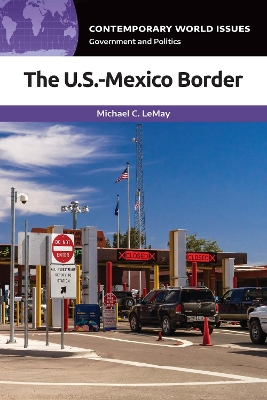Contemporary World Issues
11 total works
A valuable resource for high school, college, and general readers, this book provides an up-to-date, comprehensive examination of illegal immigration in America, addressing its complex history, comparing its occurrence today with the past, and explaining why a solution is so difficult to enact.
Who is coming into the United States illegally and why? What compels people to leave their country of origin? Is the United States responsible for taking care of the more than 11 million individuals who are here illegally? Are illegal immigrants helping or harming our nation's economy and infrastructure? Should our borders be "secured" as called for by many politicians? This book examines the history of illegal immigration in the United States, addressing the tough questions about the issue and describing in detail the most significant issues and events in recent decades. It succinctly tackles the topic of illegal immigration without bias, explores the myriad of problems and controversies that have arisen due to illegal immigration, and explains how lawmakers have historically tried—and continue to try—to solve these issues.
This thoroughly revised and updated second edition ofIllegal Immigration: A Reference Handbook covers the debate over the vexing and seemingly intractable illegal immigration problem from all angles and updates the discussion to 2015. It covers the key court, executive, and legislative-branch actions on the matter and examines both state and national-level government attempts to cope with illegal immigration. The book also contains a variety of primary source documents in summary format that cover all the key laws enacted, presidential or state governor's executive actions taken, and key court decisions since 1985. These documents not only provide factual data but also give context that allows readers to better grasp the complexity of the problem and the difficulty in trying to improve the situation through regulation.
This book provides a comprehensive summary of the creation of the Department of Homeland Security and efforts to protect the United States from international terrorism.
Homeland Security: A Reference Handbook covers the precursor events and laws from 1965 to 2000 that set the stage for the 2002 law that established the Department of Homeland Security. It identifies and discusses a dozen problems associated with homeland security policy objectively, allowing readers to come to their own conclusions. Additionally, it addresses all of the major units and agencies within the department.
Comprehensive in scope and accessible in style, it discusses 46 organizations and profiles 50 actors. Unlike many books on the topic, it provides excerpts and summaries of data, presented in figures and tables and as documents from court decisions, presidential actions, and key laws to implement homeland security policy. It also annotates key secondary sources on the topic, including books, scholarly journals, films, and videos to guide the reader to further research on the subject.
- Provides readers with an objective, nonpartisan perspective on the complexity of enacting and implementing homeland security policy so that readers may better understand how difficult it is to combat terrorism
- Illuminates how "lone-wolf" terrorists become radicalized and why they are so difficult for the government to protect against
- Suggests more than a dozen proposed solutions to the vexing problems associated with protecting the United States from international terrorism
- Details how immigration and homeland security are inherently related, and why Arab- and Muslim-American minorities suffer the brunt of the negative effects of the nation's border security crackdown
- Explains why unauthorized immigration from Mexico and Central America has risen exponentially since 1970 and why policy to deal with illegal immigration poses such a conundrum
This volume thoroughly examines the operations and politics of the U.S. Congress. It guides readers to their own assessment of congressional politics and provides them with the basis for future reading and study of the subject.
The American Congress: A Reference Handbook covers Congress from its inception to the present day, discussing the constitutional functions of Congress and how they have evolved over time. It presents a detailed discussion of 15 problems with which Congress copes, some associated concerns with those problems, and how they might be resolved.
The book opens with a brief history of Congress and how it has changed over time. It discusses a series of problems and concerns, and proposed solutions to those problems. It also comprises nine original essays by other scholars and persons involved in congressional politics as well as profiles of the major organizations and actors involved. Data and documents and a detailed chronology of Congress from 1789 to 2018 allow readers to situate significant legislation within the history of Congress, while an annotated list of sources-the major books and scholarly journals concerned with Congress in addition to a number of feature-length films and videos-provide readers with vetted resources for further study.
- Presents the major functions of Congress and how they have evolved
- Discusses proposed solutions to more than a dozen major problems facing Congress and enables readers to judge for themselves whether or not such solutions are likely to work or may have unforeseen consequences
- Synthesizes a comprehensive body of scholarly discussion on Congress, providing readers with a foundation for additional reading and research
- Explains why hyper-partisan politics, also known as "tribalism," has developed in Congress and why it leads to a stalemate in lawmaking
- Provides readers with an understanding of the checks and balances system, and why Congress often fails to exercise those powers
First Amendment Freedoms: A Reference Handbook offers a comprehensive examination of the discourse on First Amendment freedom issues in an objective and unbiased manner and provides valuable data and documents to guide readers to further research on the subject.
First Amendment Freedoms: A Reference Handbook provides a comprehensive, objective, and accessible source of critically important information on the First Amendment freedoms of religion, speech, and assembly, and the post-Civil War Fourteenth Amendment. Geared for high school and college readers, it covers relevant historical events from the adoption of the Constitution and the Bill of Rights to the array of Supreme Court cases that further defined the scope and limits of First Amendment freedoms.
Composed of seven chapters, plus a glossary and index, the volume will present the background and history of the First Amendment; problems, controversies, and solutions; a perspectives chapter with nine original essay contributions; profiles of the leading actors and organizations involved in First Amendment politics; governmental data and excerpts of primary documents on the topic; and a resources chapter comprising an annotated list of the key books, scholarly journals, and nonprint sources on the topic. It closes with a detailed chronology of major events concerning First Amendment freedoms.
- Provides readers with a better understanding of the complexity of First Amendment freedoms and how those freedoms have clashed over time
- Discusses attempts to "solve" problems concerning the fundamental freedoms defined by the First Amendment and how those attempts have changed and expanded over time
- Arms readers with a detailed list and analysis of all of the major or "landmark" Supreme Court cases pertaining to each of the fundamental First Amendment freedoms
- Makes a comprehensive but objective review of more than 50 scholarly books on the topic
What historical factors transformed American politics into the institution we know today? This in-depth look at America's party system traces its efficacy, sustainability, and popularity through six influential presidencies spanning 1790 to the present day.
Did President Obama's election serve as the impetus to the development of a seventh political party system? This compelling text sheds light on the American political process as seen through the lens of six pivotal presidencies that shaped America's culture, politics, and society and considers how our current president may be the latest transformative leader in this lineage. Covering two centuries of politics, the work offers insight into the American political machine and reveals how and why the two-party system became so dominant in American politics. Topics include the media's focus on the horse-race aspect of elections, the declining importance of party identification, and the impact of the geographical split that results in swing-states and gerrymandered districts.
The work begins by dividing 200 years of politics into 6 periods influenced by a transformative president and discussing the profile of the party system in each era. The next section presents essays contributed by activists across a myriad of political parties and profiles leading political actors and organizations. The final section includes tables, primary source documents, reference lists, a detailed glossary, and a timeline of the development of American political parties that help elucidate the text and show the role political parties have played throughout history.
The American Congress: A Reference Handbook
by Sara L. Hagedorn and Michael C LeMay
This book provides the answers to controversial questions about religious liberties in the United States and connected issues through balanced, thorough, and nonjudgmental coverage of the issues in a reference format.
The subject of religious freedom is important to all American citizens, regardless of religious affiliation or ethnicity. Are the rights of religious individuals being eroded, or is religion being unfairly used to deny basic secular rights to individuals? How will religious institutions adapt to changes in legislation that have an impact on how they operate? Does the Supreme Court have the right to enforce these changes? Finally, how can the precarious separation of church and state be maintained while simultaneously respecting both institutions?
This single-volume work provides an introduction that addresses the historical background of religious freedom in America, accurately explains the latest legal developments in religious freedom in the United States, and presents an unbiased account of the probable impact of the new Freedom of Religion laws in the continuing culture war. Readers will gain insight into key controversies such as prayer in public schools, creationism versus evolution, abortion, religious objections to medical care, religious displays in public places, same-sex marriage and LGBT rights, and state and federal religious freedom acts. The book also includes perspective essays by outside contributors, a selection of useful primary documents, a listing of print and nonprint resources, a chronology, and a glossary of terms.
This book offers answers to essential questions about the border between the United States and Mexico and connected issues that are accessible to readers interested in immigration, border security, and U.S.-Mexico relations.
Comprising seven chapters, The U.S.-Mexico Border: A Reference Handbook surveys the complex topic for students and readers. Chapter 1 discusses the political, social, and economic contexts in which the border came to exist. Chapter 2 discusses problems, controversies, and proposed solutions. Chapter 3 consists of original essays contributed by outside scholars, complementing the perspective and expertise of the author. Chapter 4 profiles major organizations and people who, as stakeholders in border politics, drive the agenda on the issue. Chapter 5 presents data and documents on the topic, giving readers the ability to analyze the facts. Chapter 6 provides additional resources that the reader may wish to consult, such as books, journal articles, and films. Chapter 7 provides a detailed chronology of important events, and the book closes with a useful glossary of key terms used throughout the book and a comprehensive subject index.
- Helps the reader to better understand the complicated U.S.-Mexico border region
- Allows different perspectives to be heard from many individuals who are concerned with border issues, from immigration advocates to residents of border towns
- Aids the general reader who wants to learn more about the history and current events concerning the U.S.-Mexico border in an easy-to-understand fashion
- Provides an objective perspective in the immigration debate
The Judicial System: A Reference Handbook provides an authoritative and accessible one-stop resource for understanding the U.S. judicial system and its place in the fabric of American government and society.
The American judicial system plays a central role in setting and enforcing the legal rules under which the people of the United States live. U.S. courts and laws, though, are complex and often criticized for bias and other alleged shortcomings, The U.S. Supreme Court has emerged as a particular focal point of political partisanship and controversy, both in terms of the legal decisions it hands down and the makeup of its membership.
Like other books in the Contemporary World Issues series, this volume comprises seven chapters. Chapter 1 presents the origins, development, and current characteristics of the American judicial system. Chapter 2 discusses problems and controversies orbiting around the U.S. justice system today. Chapter 3 features a wide-ranging collection of essays that examine and illuminate various aspects of the judicial system. Chapter 4 profiles influential organizations and people related to the justice system, and Chapter 5 offers relevant data and documents about U.S. courts. Chapter 6 is composed of an annotated list of important resources, while Chapter 7 offers a useful chronology of events.
- Explains the responsibilities and authority of the United States' many different types of courts and how they fit together
- Explores major controversies surrounding the U.S. judicial system, including politicization of the courts and bias in the criminal justice system
- Provides wide-ranging perspectives on the judicial system from reformers, court employees, and scholars
- Provides a comprehensive annotated list of resources for further reading and research
